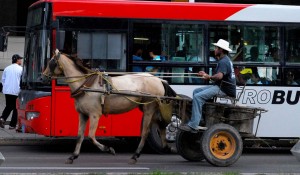Change Makers for Cuba’s Bus Stops
Regina Cano

“You lose 20 and win 40,” touted this almost 50-year-old man. Nice looking and well dressed, he was standing at the stop for the “P line” bus, the heaviest trafficked route in the capital city.
What he was offering was a chance for each individual to change 1.00 peso for 0.80 cents, which would mean a 20 cent profit for him, and 40 cents ending up in their pocket. Otherwise they’d have to drop the whole peso in the box and get back nothing.
He was armed with a sealed metal box — carried securely in both hands — that was full of change and that discreetly called would-be passengers’ attention as he circulated among the crowd.
And hey! – perhaps some people had already seen this as a business opportunity for an additional honest and well-remunerated occupation or thought some state business would take it on to satisfy peoples need for change, but he had acted.
In any case, when that man showed up it was a relief for everyone present. People made a second line to get change, demonstrating their astonishment in various ways for this gentleman appearing at that hour and at that bus stop.
The problem is that the real cost for transportation has increased because of the elimination of bus employees who used to ride on each vehicle selling tickets and giving change. Now passengers without change are either forced to pay with a whole peso, or to share the cost with another passenger (in the best of cases), or to give the peso directly to the driver (instead of the bus company), or — as is occurring with ever greater frequency — to simply refuse to deposit anything in the money box.
Traveling by bus in Havana often means taking more than one route to go to and from one’s destination and there are no transfers. This means that bus transport may end up costing 4 pesos or more daily – every work day. If you add this expense — 20 percent or more of one’s income — to the costs of food, housing, electricity, gas, clothes and other expenditures, the pockets of the majority of people end up screaming by the middle of the month.
Over the recent period there’s been a crackdown on the part of drivers to make people pay their fares – something that impacts directly in their ability to work. Nevertheless many passengers have opted to play dumb.
Therefore where the money box used to receive a couple of coins that don’t add up to the full 40 cent fare, in a new tactic these days more “self-conscious” folks will pull out larger bills to justify their lack of “petty” cash.
Meanwhile, it’s more common to hear the drivers announce: “Those who don’t have anything to pay (those who are broke), should ask the person in front or in back of them to pay.” Yet it’s common for passengers to simply look at that driver with indifference — or not look at him at all — and they file on into the bus, usually more worried about finding a place to sit or to stand with the least discomfort.
Any measure to reduce the hassle of people getting change, something unquestionably necessary, would help to increase payments for urban transportation. The danger is that what is now turning into common behavior will become difficult to reverse shortly. While the state entities don’t see the profit in dispersing change their might be a job option for any citizen.
We’ll have to see for how long this new position of “change maker” lasts. We’ll have to see how long he can run the risk involved in carrying out his work, because I don’t think it’s included as a licensed trade within the new laws regarding self-employed workers.
As for me, I wish him nothing but luck. I only hope that the police don’t pick up this guy at the “P line” bus stop or any of those who are going to follow his example in that occupation.






Comments are closed.